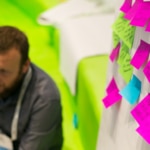Creativity and empathy, the keys for applying the "Design Thinking" methodology
Adam Royalty, Hannah Lippe and Daniel Stringer, teachers at the d.school at the University of Stanford, outline this process with practical exercises to encourage creativity and empathy.

If they had to agree on a brief and straightforward definition of what the Design Thinking methodology is, all the experts would probably describe it as “A good tool to help find a creative solution for a problem”.
And the very first questions that come up are: how does it work? What do I have to do? Adam Royalty, Hannah Lippe and Daniel Stringer, teachers at the d.school at the University of Stanford, have a one- word answer to that question:creativity.
However the word creativity probably triggers an array of protests, of which the most frequent is “I'm not creative” . These young teachers are here to prove this is wrong, because the key lies in having empathy, in making the effort to know the person, know what they need, what they want, what they desire.
Adam Royalty gives some tips for learning part of this creative process:
- People. Make sure not to be remote from them, from how they live their lives.
- Innovators. Invest in people, encourage creativity, to help them become innovative people in the future.
- Trust. Help people recapture that playful creativity they had in childhood. We have to help give free rein to creativity.
- Learning. This can all be achieved by learning through experience, as a way of embracing the Design Thinking.
Putting it into place
One of these experiences involved actually being able to take part this process. At the FinDesign event in the BBVA Innovation Center, these three teachers showed over 100 people how to apply these guidelines in Design Thinking methodology.
The exercises were simple, fun, emotional and very creative. Hannah Lippe broke the ice by “making” the participants introduce the people sitting next to them. The first timid greetings gradually evolved into selfies and a minor commotion. The fun started when Hannah asked the participants to greet someone who “doesn't smell very nice”, and then a friend they hadn't seen for over ten years.
“It's very important to engage the body and mind in the creative thinking process. Empathy is fundamental for identifying the skills of the people around us”, says Lippe when defining this process.
And to reinforce empathy, what could be better than another exercise? Hannah proposes drawing your ideal wallet in three minutes But then comes the key exercise: “interviewing” your partner, finding out what he or she wants in a wallet, how he would use it... It's the other person's knowledge that will give you the key to the design. Once again after the exercise, you have to write just a few words describing what you've extracted from that “chat”: what her wishes are, her most important need.
By now we know the person and we've identified the problems, but not the solutions. Daniel Stringer suggested conducting a team brainstorming session, but pointed out that although it seems incredible, we need to follow some rules before working on other people's ideas.
“Yes, and…”. This expression is the key to those rules. When someone proposes an idea, don't just tear it down without adding or supplementing it with some new insights. “It's not a case of selling your ideas, but of achieving more information about everyone else”. Once you've gathered all the information, then you can think about a design.
This process also allows you to get to know other people, which leads to opportunities to innovate because you come to different conclusions when you combine different knowledge and ways of thinking. With these ideas in a group, the concentration is different and the process is enriched by working in a team.

The Key points of Design Thinking
Adam Royalty points out that if you want to tackle a problem using this methodology you should follow three key steps:
- Empathize with the customer and concentrate on the human value.
- Prototype the idea based on the knowledge you have of the customer
- Reformulate the problem
What the d.school encourages most in students is to work on their self-confidence. “There's a tremendous need to work on your own self-confidence, because that's what ultimately unblocks people's potential”, says Hannah Lippe. “Young people are hoping to be given an opportunity to be creative”.
In the same line, Daniel Stringer explains that there are different ways of deploying these processes in a company. “It's important to assess each case carefully. Sometimes the most effective way is to capture the imagination of the CEO, whereas at other times the best thing is to organize small courses and then form a small group of the most motivated people so they gradually infect the rest of the organization”.
Stringer mentions the evolution of Citrix as an example in the financial sector, as “for years they 've trained all their new employees in this methodology” and so “they've succeeded in introducing Design Thinking in their corporate culture”.
“Design Thinking may be a good vehicle for driving change if the company's going through difficulties”, says Stringer.